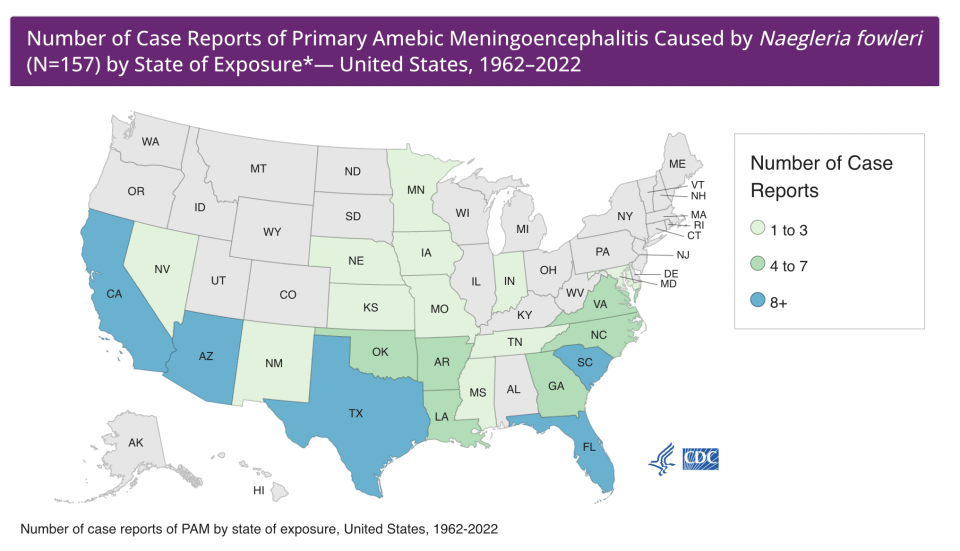'Brain-eating amoeba' cases peak in the summer: What to know about Naegleria fowleri symptoms
The risk of getting a “brain-eating amoeba” or Naegleria fowleri from swimming is incredibly rare, with only 29 infections in the United States since 2013.
But the freshwater amoeba is known for causing sudden deaths, especially among minors. While you’re unlikely to be infected, warmer temperatures from climate change might make them more common.
Earlier this year, a Florida resident died after contracting Naegleria fowleri, possibly a result of the person rinsing their sinuses with tap water, state health officials said. And in 2022, a Nevada boy who contracted the amoeba − potentially at Lake Mead − died from the infection.
Here’s what you need to know to be safe this summer.
What is Naegleria fowleri, or a brain-eating amoeba?
Naegleria is a single-celled organism found in warm freshwater and soil according to the Centers for Disease Control and Prevention. Naegleria fowleri, the only fatal species, enters the body when water gets in through the nose. On rare occasions, it can cause Primary Amebic Meningoencephalitis (PAM), a brain infection that destroys brain tissue.
Most infections have come from swimming in freshwater bodies, such as lakes, rivers or hot springs. Very rarely, infections occurred from pools or water parks with insufficient chlorine levels.
Early symptoms usually start about five days after infection and include a sudden onset of fever, headache, vomiting, or a stiff neck. As the disease progresses, symptoms include confusion, seizures, hallucinations, and coma.
Texas fish kill: Thousands of dead fish washed ashore beaches along the Texas Gulf Coast. Here’s why.
How many people die? How rare are infections?
Again, rates of infection are incredibly low, with less than eight cases reported annually, according to the CDC. However, Naegleria fowleri is incredibly lethal. Among known infections since 1962, only four individuals have survived the amoeba, resulting in a 97% fatality rate.
For a reason yet to be identified by experts, the majority of cases are seen in males under 14 years old. Some theorize this is simply due to that population being the most active in swimming in these locations.
Specific diagnostic tests for the amoeba are available in only a few labs in the U.S., and infections are so rare and tough to initially detect that 75% of diagnoses are made after death, according to the CDC.
The majority of infections occur in July and August, per the CDC.
Shark stats over 47 years: Where is the shark attack capital of the world?
Where is Naegleria fowleri found? What states have the most infections?
The most common locations for infection are lakes, ponds or reservoirs, followed by rivers, canals, ditches, puddles and streams, as Naegleria fowleri thrives in water temperatures above 80 degrees.
The majority of cases since 1962 have occurred in the South − primarily in Texas (39) and Florida (37) − as well as in the West, where California (10) and Arizona (9) have recorded the most cases.

How climate change could affect Naegleria fowleri infections
With rising temperatures due to climate change, it’s possible that Naegleria fowleri infections will become more common, said the CDC. Warmer air temperatures result in warmer waters and more favorable conditions for the amoeba to grow.
In the past decade, cases have been confirmed in more northern areas including Nebraska, Iowa, Minnesota, Indiana, Maryland, and Northern California.
The risk of Naegleria fowleri is higher during and after heat waves, when water temperatures are warmer. The amoeba have been known to survive temperatures as high as 114.4 degrees Fahrenheit.
How to avoid Naegleria fowleri
The CDC recommends avoiding activities that allow freshwater to go up the nose, like jumping or diving into water. It recommends holding or plugging one’s nose when going underwater, and to not put one’s head under a hot spring.
Naegleria fowleri is found in the soil or sediment of freshwater bodies, so avoid digging or stirring up the bottom of lakes or rivers.
Overall, cases are rare, but avoiding getting water up one’s nose is a helpful water safety precaution to take this summer.
Contributing: Ashley R. Williams and Wyatte Grantham-Philips, USA TODAY
This article originally appeared on USA TODAY: 'Brain-eating amoeba': Naegleria fowleri symptoms, where it's found

